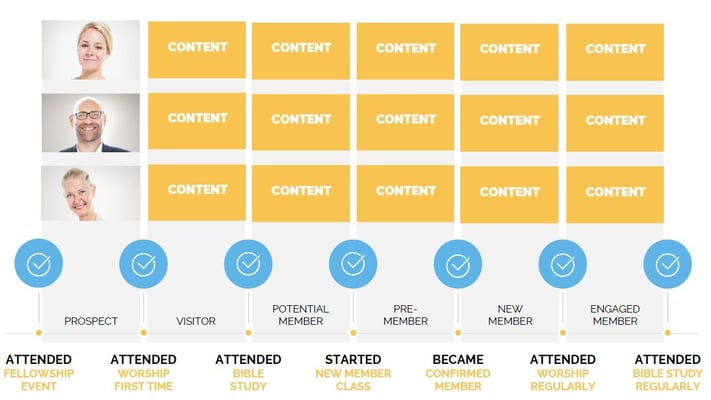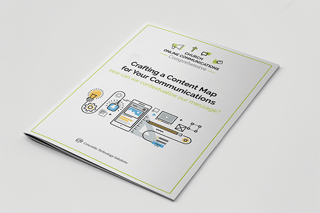
If you're just starting to follow along, this is the seventh session in our fourteen-week series about online communications in the church. Every week, a different communication strategy has been defined and shown how to apply in a strategic manner.
Recently, the topics have focused on audience personas, journey maps, and message maps. This week, we will explore how to combine these three concepts and apply them in a very practical action plan called a content map.
What is a content map?
Simply put, a content map represents the messages you want to communicate with your audiences at different stages of your journey map.
In a content map, a grid is created that identifies appropriate content for each individual persona at every stage in the journey map. While each content item will eventually have an appropriate delivery vehicle (like an email, blog post, video, etc.), it's important to focus on the message before deciding the means.

What kind of “content” should be shared?
“Content” is a very broad term; when I use “content,” I mean messages delivered through emails, blog posts, videos, or social messages. In fact, in some cases, the most appropriate delivery vehicle for content is a phone call or an in-person visit. The important thing is to make sure the right message is getting to the right person at the right time.
That's why the message map is so important. Because it flows from your goals and is directly related to your journey map and audiences, it should serve as the basis for each item on your content map.
Why is content mapping important?
Content mapping provides a personal contact at individual stages of the journey map. It takes the journey map and asks, “What does this mean within the context of your personas?”
When working with individuals in the church, we have to remember that there is no such thing as one-size-fits-all. Each persona has different needs. Each place on the journey map requires different attention. When you look at a person, you have to understand where he or she is in your journey map and what his or her persona is.
In doing this, you can get specific and relevant with the content you share. This will help you make the right message for each person. In other words, the message you have will change depending on both the persona and the journey map.
The breadth and variety of messages might seem a bit overwhelming, but in one sense, it can actually make communications a lot easier. Rather than trying to come up with a message that is broad enough for all audiences, it lets you hone in on a specific situation.
Personalizing the message by persona
If you have Millennial Melody and Older-Adult Alice who both attend worship regularly, but not Bible study, can you give them the same invitation to the same class? Maybe, but it's certainly not going to be as effective. Using a content map will help you understand what content is applicable for Millennial Melody and what Older-Adult Alice needs to continue along her journey.
Millennial Melody might need young adult Bible studies so she can grow with other people her age. She might prefer communication through text rather than phone calls.
Older-Adult Alice would most likely prefer a Bible study with people closer to her age so that she can connect with people in her similar life-stage. She might prefer phone calls or emails to communicate.
Personalizing the message by stage
In the same way, you wouldn't communicate with a non-member in the Visitor stage like you would with a person in the New Member stage.
In the Visitor stage, that person may not yet see the value of being a part of the body of Christ as a member of the church, so asking him or her to attend Bible study regularly is certainly a stretch. However, asking him or her to attend one study will give him or her a taste of the community and the additional understanding of Scripture that he or she will receive.
However, in the New Member stage, that person should already have an understanding of the importance of being an active member of the body of Christ; now he or she just needs to know what that means. Asking him or her to faithfully attend worship and Bible study at that stage is a different kind of request, even it's the same subject matter.
How do I complete my content map?
In each content map, you’ll begin by listing the different personas in your church, and then you’ll list the different stages of your journey map. How you set it up isn't as important as getting the concept correct, so personas may be either rows or columns and stages can be the other.
Use these columns and rows to make a matrix of content. I personally recommend starting with the types of communication you currently do on a regular basis. Do you do something for each visitor? Put it on the map in the appropriate persona(s). Do you provide a welcome packet for each new member? Determine the best place to put that item.
Just like with different activities on a message map, don't try to force something that doesn't fit. It's possible that activity is no longer worth the effort since it doesn't clearly support your goals.
Finally, and this is the fun part, identify where you have gaps and go back to your message map to gain ideas on what you should include in that spot. It may seem overwhelming when you're done, but just remember that each time you implement a new piece of content identified on your map, you're better off than you were before.

Start Creating Your Message Map
Download the Crafting a Content Map for Your Communications. This free PDF provides a template of a content map that will help you get started on mapping out content for each persona and each stage of your church.

Free Training Course
This blog post was part of the training series Church Online Communications Comprehensive. All the course materials are available online for free, and you can move through the course at your own pace. Start working toward an effective online communications strategy for your church today!
About the Author
Follow on Linkedin More Content by Peter Frank























